MANITOULIN—A series of atmospheric rivers dumped unprecedented amounts of rain in southwestern areas of British Columbia and into the northwestern United States throughout November, causing widespread flooding and infrastructure damage that impacted supply chains across the country. Recent research suggests these rivers of water vapour in the atmosphere can also impact the Great Lakes region, including Lake Huron.
There are numerous studies on atmospheric rivers, but these are largely focused on long western oceanic coastlines rather than inland phenonema. Marian Mateling, a researcher at the University of Wisconsin-Madison, is the lead author of a 2021 study that looks at the influence of atmospheric rivers on cold-season precipitation in the upper Great Lakes region. The study used data from a weather station in Marquette, Michigan, on the southeast coast of Lake Superior.
Basically, the study looked at how often atmospheric rivers coincided with heavy snow events. Lake effect snow and more intense storms originating in the midwestern United States provided equal amounts of precipitation but almost 30 percent of the intense winter storms were affected by atmospheric rivers.
There is an avenue for moisture from the Gulf of Mexico straight up into the Great Lakes, said co-author Claire Pettersen, a professor the University of Michigan’s Climate and Space Science and Engineering faculty. “In general, atmospheric rivers are really big, long thin tendrils of moisture. They are one of the major ways moisture moves from lower to higher latitudes.”
“Atmospheric rivers act as a conduit for the water vapour to be drawn into the interior from the Gulf of Mexico,” explained Ms. Mateling. “These big systems will bring all of that water vapour up with them and then dump it as precipitation.”
When atmospheric rivers are present with these big systems, they’re more likely to bring rain in the wintertime. “Not only were you getting this oftentimes windier system and more snowfall, but you’re more likely to get rain in the winter with them,” she added. In fact, cold season precipitation events accompanied by atmospheric rivers were four times more likely to end up as detrimental rain on snow events.
That can be especially hazardous when it’s freezing rain that falls or when there is a buildup of rain and snow. This tends to be heavy, which could lead to infrastructure failure. Rain can rapidly melt snowpack, causing run-off winter or spring flooding as well.
While the researchers just looked at Marquette, the findings will impact other areas, Ms. Pettersen said. “We call them thin but they can still be 100 kilometres wide. There’s a good chance that an atmospheric river that hits Marquette would also hit Lakes Michigan and Huron and the lower Great Lakes.”
One study that looked at climate change and atmospheric rivers concluded that there would be a higher frequency of atmospheric rivers with climate change. “That doesn’t go against the grain from what we know,” noted Ms. Mateling. “In a warmer climate you will have more water vapour because you have more evaporation. More water in the atmosphere will make these stronger, more intense atmospheric rivers.”
The air tends to be warmer as well with atmospheric rivers, so that could imply there are more avenues for an atmospheric river to occur as global temperatures rise.
“We looked at seven years of data,” Ms. Pettersen stated. “There’s a lot of statistics about rain on snow and preferential weather system setups but that’s not a long enough time scale to say there’s a (climate) trend.” She pointed out that if the region is getting warmer and the baseline temperature gets higher in the winter, then theoretically there will be more rain and the percentage of winter storms affected by atmospheric rivers could go up.
Ms. Mateling’s study did not look at forecasting events and more data would be needed for this. “If we know that it’s warmer, if we know that a big system is coming in and we’re able to track atmospheric water vapour using satellites, forecasters can use all of the tools to then make decisions about the precipitation forecast,” she said. This could allow for a warning system, similar to the issuing of tornado warnings.
“We did start to look a little at the climate using a slightly longer record of atmospheric rivers that we have that date back to 1980,” she added. “We were able to see that it is strongly correlated to specific climate signals. Our long-term goals would definitely be to forecast these events and to be able to warn people in these regions to be wary driving when it’s January 15 and it might rain because it could be very unsafe.”
She worries that atmospheric rivers may be another trendy weather topic, like polar vortexes were not very long ago. “People may think it’s just another thing but I would encourage people to pay attention if their local forecaster tells them about an atmospheric river event. It might not sound like anything at all but it could potentially mean more precipitation than normal in any season and even if it’s freezing outside, it could mean rain.”
It would be great to not have global warming occurring, she said, but we do. “We can’t do much except adapt and mitigate. Pay attention and be aware.”





